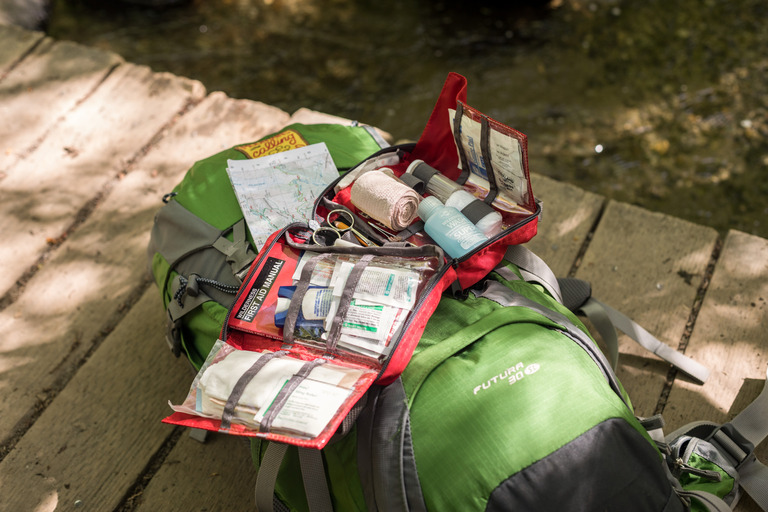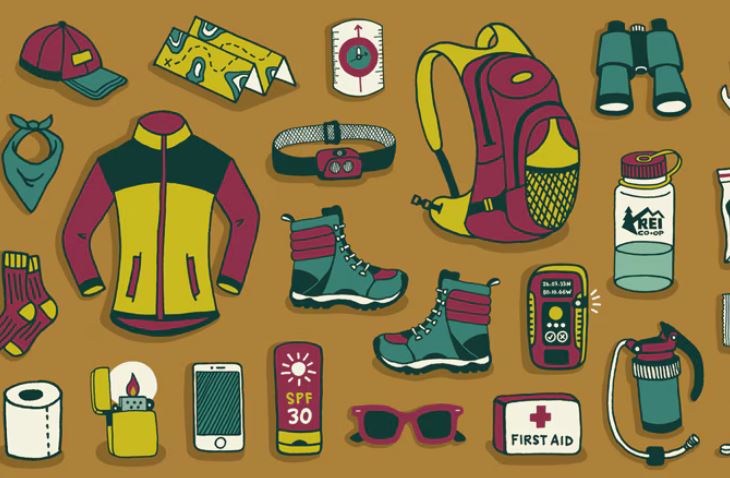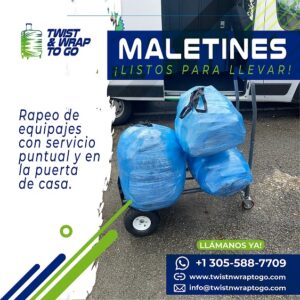“Day hiking” simply means any hiking outing that can be done in a day, as opposed to a multiday excursion like a backpacking trip or a thru-hike. A day hike can be a stroll around your local city park or a 4-hour trek up your nearest mountain. Whether it’s 2 hours or 12, getting outdoors and experiencing nature offers profound mental and physical benefits.
That being said, a 2-hour hike and a 12-hour hike are different when it comes to prep and gear. In general, the longer and more remote the hike is and the more inclement the weather, the more clothing, gear, food and water you’re going to want. Below, we’ll break day-hiking essentials down by your hike’s duration, while still considering factors like trail conditions, weather and other variables. While you’re packing for any day hike, use the appropriate handy checklist to make sure you don’t forget anything important.
Here are some notes on how to best use the lists:
How to Use These Day Hiking Checklists
While you’re packing, use these handy day hiking checklists to make sure you don’t forget anything important. Here are some notes on how to best use the lists:
- The Ten Essentials: Items that are part of the Ten Essentials are marked by an asterisk (*). The exact items you take can be tailored to your trip based on considerations such as weather, difficulty, duration and distance from help. To learn more, see our article on the Ten Essentials.
- These checklists are guidelines. They are deliberately comprehensive; your needs may vary. Adapt them to suit your hike as necessary.
- Printer-friendly PDFs. Print out the PDF version of each checklist for easy reference while packing. If you’re someone who likes to physically tick items off your list, consider laminating the checklists. Then use a dry erase marker to mark them up.
If you’re just getting into day hiking, be sure to read our Hiking for Beginners article before you head out.
What to Bring Day Hiking
These items should always be on your hiking checklist:
- Hiking pack
- Weather-appropriate clothing (think moisture-wicking and layers)
- Hiking footwear
- Plenty of food
- Plenty of water
- Navigation tools such as a map and compass
- First-aid kit
- Knife or multi-tool
- The rest of the Ten Essentials as appropriate for your hike
Jump ahead to the list that fits your needs:
- Day Hikes: 2 Hours or Less
- Day Hikes: 2+ Hours
Day Hikes: 2 Hours or Less
This list is a good starting point for a morning spent on regional park trails or a local lake walk. And while you may be tempted to just grab a water bottle and go, every hike is better when you’re prepared, so we recommend adding at least a few other bare-minimum items to your trek.
Hiking Gear
A small pack is the primary piece of gear for day hiking. You have several options for shorter hikes, from a simple bottle sling that frees your hands to a small daypack for snacks and your phone. For a longer outing, consider a 10- to 20-liter daypack that can hold those snacks and phone as well as extra layers, a first-aid kit and more. Learn more about choosing a daypack.
- Daypack (Choose one: bottle sling, waist pack, daypack, hydration pack)
Optional:
- Trekking poles
- Winter traction devices
Note on trekking poles: Not just for mountaineers, trekking poles offer a number of advantages for everyday hikers across all terrains. Poles or a staff can increase your stability and efficiency; assist when navigating obstacles and feeling secure; and take some of the pressure off your legs and knees, giving you an upper-body workout. Like daypacks, you’ll want poles that suit your specific needs. Learn more about choosing and using trekking poles.
![]()
Clothing
First step: Check the forecast. For warm and sunny days, consider how much protection your clothing will provide against the sun’s ultraviolet rays while still keeping you cool. For rain and possible inclement weather, pack an extra layer or two beyond what you’re wearing. And don’t overlook being comfortable—this experience is all about movement, so consider what clothing helps you feel secure while you’re stepping, stretching and climbing. Learn more about choosing hiking clothing.
- Moisture-wicking underwear
- Moisture-wicking shirt
- Quick-drying pants/shorts
- Long-sleeve shirt (for sun, bugs)
- Lightweight fleece or jacket
- Socks (synthetic or wool)
Additional items for rainy and/or cold weather:
- Rainwear (jacket and pants)
- Long underwear
- Warm, insulated jacket or vest
- Fleece pants
- Gloves or mittens
- Warm hat
Optional:
- Bandana or neck gaiter
- Gaiters (for rainy, snowy or muddy conditions)
Footwear
For gentle hikes on smooth or manicured trails, hiking shoes, hiking sandals or trail-running shoes may be sufficient. For treks on rocky and rugged trails, boots can provide more support and stability. That being said, your preferences may vary. Learn more about choosing hiking footwear.
- Footwear (Choose one: hiking boots, hiking shoes, trail-running shoes, hiking sandals)
![]()
Food & Water
You might not think you need to pack snacks for a 2-hour hike, but being prepared for anything is a hiker’s key to happiness. Plus, snacks can be an excuse for a mindful break. For water, you can usually start with about 1 Liter per person per hour, but adjust the amount depending on length and intensity of the hike, weather conditions, your age, sweat rate and body type. Learn more about choosing energy food and how much to drink.
- Water bottles and/or reservoir that fits into a daypack or hydration pack *
- Trail snacks (pack extra) *
- Resealable bag (for your trash—or someone else’s)
Optional:
- Lunch
![]()
Navigation
Navigation is one of the Ten Essentials. If you’re hiking relatively close to your front door, you may not want to carry navigational tools. If you’re at all unfamiliar with your surroundings, however, you’ll want to make sure you have at least one—or, ideally, two—ways to stay oriented. Note that smartphone-based apps might not work with poor or no cell service.
- Map *
- Compass *
Optional:
- Route description or guidebook
- Altimeter watch *
- GPS *
- Smartphone apps like Strava, AllTrails, Gaia and FarOut
![]()
Emergency & First Aid
You never know when you might stumble and skin a knee or get lost in a rainstorm. Even when hiking on shorter treks or less challenging trails, make sure you’re carrying a first-aid kit or first-aid supplies* (see our First-Aid Checklist). If you’re not carrying emergency supplies, make sure you have some in your car.
Whenever you’re headed into the backcountry, always bring first-aid supplies with you in your pack. Here’s a full list of what you may want to carry.
- First-aid kit or first-aid supplies *(see First-Aid Checklist)
- Handkerchief
- Pain medication (aspirin/ibuprofen)
- Antibacterial/antiseptic wipes *
Safety:
- Two itineraries: 1 left with friend, 1 under car seat
- Personal items (cell phone, ID, etc.)
- Flashlight or headlamp *
- Whistle
![]()
Health & Hygiene
- Hand sanitizer
- Menstrual products
- Toilet paper and/or urinary products
- Insect repellent *
- Prescription medications
- Baby wipes
Sun Protection
Learn more about How to Choose and Use Sunscreen.
- Sunscreen *
- Sunglasses *(+ sunglasses straps)
- Sun hat, sun visor or baseball cap *
- SPF-rated lip balm *
![]()
Tools & Repair Items
- Knife or multi-tool *
- Small gear-repair kit *(duct tape, zip ties, etc)

Day Hikes: 2+ Hours
If you’re hiking more than a couple hours—especially in the backcountry—your gear needs increase, though the basics stay the same. From extra PB&Js to additional layers, here’s what you’ll need for a longer day hike.
![]()
Hiking Gear
A good daypack is a must for longer hikes, regardless of terrain. You should make sure it fits you well, too. A pack that holds between 10 and 20 liters of gear is about right for shorter, simpler hikes; you’ll want something bigger for treks that span across mealtimes and across a range of temperatures throughout the day. (If you are in a warmer climate, for example, a hydration pack might make sense.)
When investing in a daypack, you’ll want to consider activity, capacity, features and fit.
- Daypack (Choose one: daypack, hydration pack)
Optional:
- Trekking poles
- Winter traction devices
Note on trekking poles: Not just for mountaineers, trekking poles offer a number of advantages for everyday hikers across all terrains. Poles or a staff can increase your stability and efficiency; assist when navigating obstacles and feeling secure; and take some of the pressure off your legs and knees, giving you an upper-body workout. Like daypacks, you’ll want poles that suit your specific needs. Learn more about choosing and using trekking poles.
![]()
Clothing
Check the forecast and make sure to dress for changing conditions, from morning to evening. To be prepared for variable weather or an unplanned night out, pack extra clothes beyond those required for the trip. It’s also important to consider sun exposure, altitude variation and terrain.
- Moisture-wicking underwear
- Moisture-wicking shirt
- Quick-drying pants/shorts
- Long-sleeve shirt (for sun, bugs)
- Lightweight fleece or jacket
- Socks (synthetic or wool)
- Extra clothes *(beyond the minimum expectation)
Additional items for rainy and/or cold weather:
- Rainwear (jacket and pants)
- Long underwear
- Warm, insulated jacket or vest
- Fleece pants
- Gloves or mittens
- Warm hat
Optional:
- Bandana or neck gaiter
- Gaiters (for rainy, snowy or muddy conditions)
Footwear
Let the terrain and distance determine your footwear. For gentle hikes on smooth trails, hiking shoes, hiking sandals or trail-running shoes may be sufficient; the longer the trail, the more support you’ll need—and that’s where hiking boots can come in handy. For treks with water crossings, you’ll want something that will either let your feet dry quickly (like synthetic-based sandals) or keep them from getting wet (waterproof boots).
For any hike, comfort is paramount. Whatever type of footwear you choose, you’ll want something well-fitted and broken in. Learn more about choosing hiking footwear.
- Footwear (Choose one: hiking boots, hiking shoes, trail-running shoes, hiking sandals)
![]()
Food & Water
Pack snacks like energy bars, jerky and nuts that you can eat easily on the trail; if your hike crosses mealtimes, bring a sandwich (or something similar) too. Browse our hiking and camping recipes for inspiration. For water, you can usually start with about 1 Liter per person per hour of hiking, but adjust the amount depending on length and intensity of the hike, weather conditions as well as your age, sweat rate and body type. Learn more about choosing energy food and how much to drink.
- Water bottles and/or reservoir that fits into a daypack or hydration pack *
- Water filter/purifier or chemical treatment *
- Trail snacks
- Lunch
- Extra day’s supply of food *
- Resealable bag (for your trash—or someone else’s)
![]()
Navigation
Navigation is one of the Ten Essentials. The type of trip you’re taking and your personal preferences will determine exactly which items you’ll bring. For backcountry hikes, pack a navigational tool—even if it’s just your phone—and a backup. Note that smartphone-based apps might not work with poor or no cell service.
Optional:
- Route description or guidebook
- Altimeter watch *
- GPS *
- Smartphone apps like Strava, AllTrails, Gaia and FarOut
- Satellite messenger/personal locator beacon *
![]()
Emergency & First Aid
No one is invincible to Mother Nature’s whims, so it’s better to be prepared. Longer hikes require carrying basic first-aid supplies in your pack in case of an emergency.
- First-aid kit or first-aid supplies *(see First-Aid Checklist)
- Handkerchief
- Alcohol and antiseptic wipes *
- Blister treatments
- Pain medication (aspirin/ibuprofen)
- Lighter/matches and firestarter *
- Emergency shelter *
Safety:
- Two itineraries: 1 left with friend, 1 under car seat
- Personal items (cell phone, ID, etc.)
- Flashlight or headlamp *
- Whistle
Bear spray
![]()
Health & Hygiene
- Hand sanitizer
- Menstrual products
- Toilet paper and/or urinary products
- Insect repellent *
- Prescription medications
- Baby wipes
Sun Protection
Learn more about How to Choose and Use Sunscreen.
- Sunscreen *
- Sunglasses *(+ sunglasses straps)
- Sun hat, sun visor or baseball cap *
- SPF-rated lip balm *
![]()
Tools & Repair Items
- Knife or multi-tool *
- Small gear-repair kit *(duct tape, zip ties, etc)
![]()
Day Hiking Extras
- Headlamp or flashlight *(with extra batteries)
- Camera
- Interpretive field guide(s)
- Outdoor journal with pen/pencil
- Binoculars
- Two-way radios
Text taken from: https://www.rei.com




